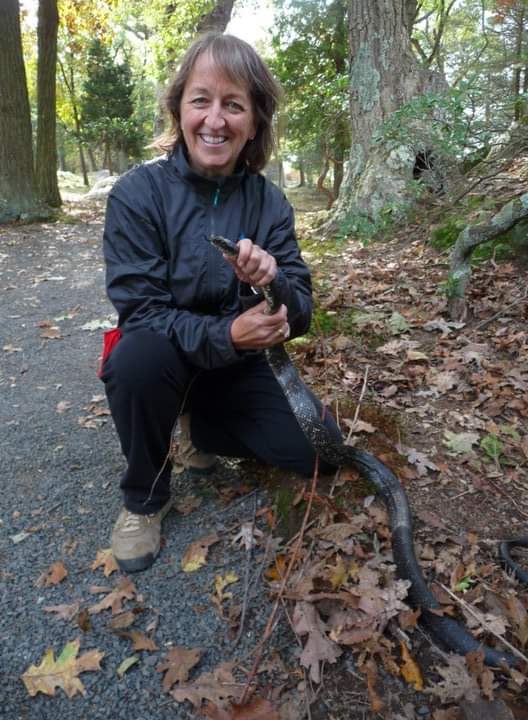
Snakes commonly prey on the contents of nestboxes. See signs and types of snakes most likely to be a problem. Some snakes can slither straight up vertical surfaces – including glass – without difficulty. Keith Kridler says a rat snake or coach whip snake can stand up two thirds of their body length and reach into a nestbox without touching the pole or guard. Each of these species often reaches seven feet in length and can be over 9 feet.
Adult birds often see a snake long before it is at the box (i.e. anywhere near the trap). If there are babies in the box, at the mere sighting of a snake, adults will make extreme efforts to fledge the nestlings. If the nestlings are old enough to have their eyes open, they will make every effort to heed the adults’ panic call. If they are not old enough, they will fledge prematurely and often drop to the ground right in the snake’s path.
Some bluebird monitors claim that snakes “remember” locations where they have successfully fed on eggs/nestlings, so take extra care in boxes that have experienced predation in the past.
Monitoring: In any area prone to snakes, always exercise care when opening a nestbox. To be ‘greeted’ by a coiled snake is an unnerving experience. Do not put your hands where you can not see – use a telescoping mirror instead More than one bluebird monitor has been hurt falling over from the surprise of finding a snake curled up inside a box – especially if they are on a ladder. Read more on Monitoring.
Here are some methods that may help protect nestbox contents from snakes.
- Keeping grass well trimmed within a large perimeter of the box might well be the best deterrent for snakes. Trim grass and weeds around poles boxes are mounted on, as snakes like cover.
- Put a five foot length of smooth 4″ PVC over the pole, inside a one foot diameter circle of clean sand. Keep grass and brush trimmed around pole.
- Charged electric fence wire alternated with ground wires surrounding the pole is very effective. However, it’s expensive, requires power near the poles, and isn’t recommended if there are children around.
- Small-diameter, smooth metal poles help: After making sure there are no utilities underground, use a five-pound maul to hammer a five-foot length of steel reinforcement rod (“rebar”) half way into the ground. (Rebar is available from any concrete supply company.) Next, slip a five-foot length of half-inch metal electrical conduit over the rebar. The nest box is attached to the conduit with a pair of two-hole, half-inch conduit clamps. (Conduit and clamps are available from any hardware store.) (Source: Wisconsin Natural Resources Magazine. Using 0.5″ conduit instead of wood or larger diameter metal poles results in far fewer nests lost to predation. For folks with many nestboxes on trails and a limited budget, more birds were fledged than if metal T-posts or U- posts or wooden posts were used.
- Polishing and greasing a narrow diameter pole works, too, but only if the pole is regularly cleaned and regreased before the old grease collects dust and/or hardens in the sun enough to allow the snake to crawl over it. It helps to rub the steel poles with fine steel wool. If you gently rub a silk handkerchief down the pipe and it snags on anything every 6″, a snake can probably climb it.
- The ‘Kingston Guard‘ (a stovepipe baffle) stops many snakes (other than a big rat snakes, which can climb along the seam). It is the standard for predator protection many Bluebird societies. But a snake that can rise up 3/4 of their own length, can easily by-pass raccoon baffles.
- A 3′ square piece of hardware cloth placed below the nestbox like a Kingston Guard.
- Avoid hanging boxes in areas like Louisiana where tree-climbing carnivorous snakes are prevalent.
- There are some effective pole-mounted snake traps. All are lethal to the snake, unless watched constantly to immediately free the snake. Keep in mind that some snake species are protected by regulation.
- The ‘Krueger Snake Trap‘ is also effective. Bird netting is both inexpensive and effective, especially when combined with a Kingston baffle. See PLAN.
- Remove snakes that are caught – they will die, and the parents may abandon the nest if the snake remains. Also, having a snake in there may freak out the parents and result in premature fledging.
- Does Sulphur work? Some people say it does – stinks to high heaven, but try it around the base of the pole/post. Garden variety sulphur is what people use.
WHAT DOES NOT WORK: naphthalene, rope. No chemical applications have ever been found to be effective in an outdoor setting, despite claims from distributors. Noel Guards can protect against raccoons, cats and avian predators, but will not deter snakes. Large snakes can get over 24″ diameter cone guards.
More Information and Other Resources:
- North American Snake ID
- Problems & Solutions: Predator ID
- Monitoring
- Predator Guards – Pros and Cons
- Kingston Stovepipe Guard (Raccoons and some snakes)
Every great story seems to begin with a snake.
– Nicolas Cage
